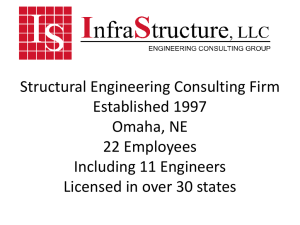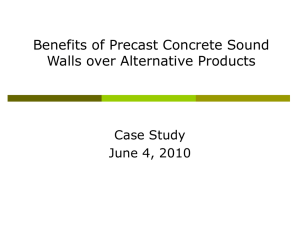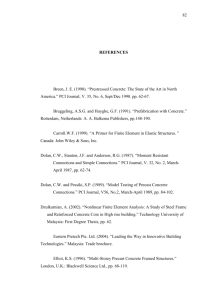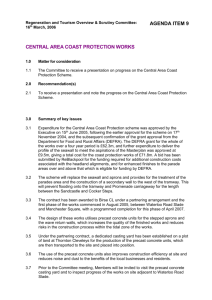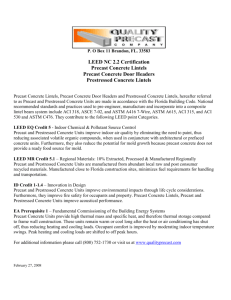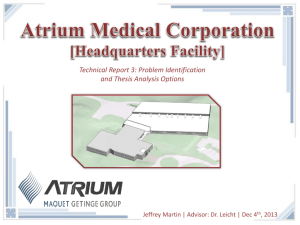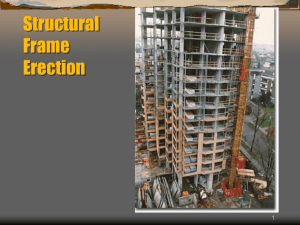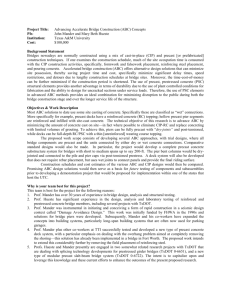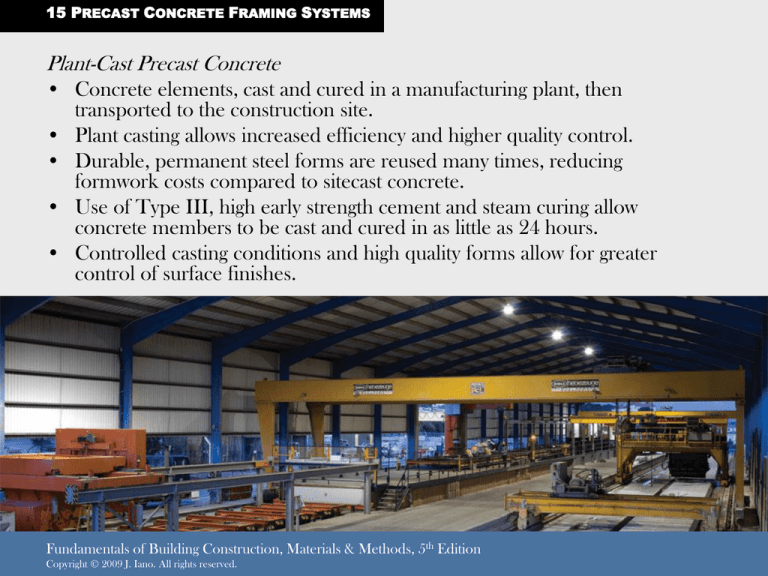
15 PRECAST CONCRETE FRAMING SYSTEMS
Plant-Cast Precast Concrete
• Concrete elements, cast and cured in a manufacturing plant, then
transported to the construction site.
• Plant casting allows increased efficiency and higher quality control.
• Durable, permanent steel forms are reused many times, reducing
formwork costs compared to sitecast concrete.
• Use of Type III, high early strength cement and steam curing allow
concrete members to be cast and cured in as little as 24 hours.
• Controlled casting conditions and high quality forms allow for greater
control of surface finishes.
Fundamentals of Building Construction, Materials & Methods, 5th Edition
Copyright © 2009 J. Iano. All rights reserved.
15 PRECAST CONCRETE FRAMING SYSTEMS
Plant-Cast Precast
Concrete
• Structural elements are
commonly reinforced
with tightly stretched
pretensioned steel
strands, which provide
increased structural
efficiency.
• Conventional steel
reinforcing is added for
resistance to thermal
and other secondary
stresses.
Fundamentals of Building Construction, Materials & Methods, 5th Edition
Copyright © 2009 J. Iano. All rights reserved.
15 PRECAST CONCRETE FRAMING SYSTEMS
Plant-Cast Precast Concrete
• On the construction site,
precast concrete elements
are lifted into place and
assembled into structural
assemblies in a process
similar to that used for
structural steel.
• Compared to sitecast
concrete, precast concrete
erection is faster and less
affected by adverse
weather conditions.
A vacuum lifting device is used to lift and place precast
concrete pranks.
Fundamentals of Building Construction, Materials & Methods, 5th Edition
Copyright © 2009 J. Iano. All rights reserved.
15 PRECAST CONCRETE FRAMING SYSTEMS
PRECAST,
PRESTRESSED
CONCRETE
STRUCTURAL
ELEMENTS
Fundamentals of Building Construction, Materials & Methods, 5th Edition
Copyright © 2009 J. Iano. All rights reserved.
PRECAST, PRESTRESSED CONCRETE STRUCTURAL ELEMENTS
Precast Concrete Slabs
• Used for floor and roof decks.
• Deeper elements (toward the right
below) span further than those that are
shallower (toward the left).
• Right: Hollow core slabs stacked at the
precasting plant.
Fundamentals of Building Construction, Materials & Methods, 5th Edition
Copyright © 2009 J. Iano. All rights reserved.
PRECAST, PRESTRESSED CONCRETE STRUCTURAL ELEMENTS
Precast Concrete Beams and Girders
• Provide support for slabs.
• The projecting reinforcing bars will bond with concrete cast on site.
• Right: Inverted tee beams supported by precast columns.
Fundamentals of Building Construction, Materials & Methods, 5th Edition
Copyright © 2009 J. Iano. All rights reserved.
PRECAST, PRESTRESSED CONCRETE STRUCTURAL ELEMENTS
Precast Concrete Columns
and Wall Panels
• Provide support for
beam and slab
elements.
• Since these elements
carry mainly axial loads
with little bending force,
they may be
conventionally
reinforced without
prestressing.
• Or, long, slender
multistory elements
may be prestressed to
provide resistance to
bending forces during
handling and erection
(columns at right).
Fundamentals of Building Construction, Materials & Methods, 5th Edition
Copyright © 2009 J. Iano. All rights reserved.
PRECAST, PRESTRESSED CONCRETE STRUCTURAL ELEMENTS
Precast Concrete Columns and Wall
Panels
• Precast concrete wall panels may
be solid (right), hollow, or
sandwiched (with an insulating
core).
• Wall panels can be ribbed, to
increase their vertical span
capacity while minimizing weight,
or formed into other special
shapes (below).
Fundamentals of Building Construction, Materials & Methods, 5th Edition
Copyright © 2009 J. Iano. All rights reserved.
PRECAST, PRESTRESSED CONCRETE STRUCTURAL ELEMENTS
Other Precast Concrete Elements
• Precast concrete stairs (below)
• Uniquely shaped structural
elements for a sports stadium (right)
• Etc.
Fundamentals of Building Construction, Materials & Methods, 5th Edition
Copyright © 2009 J. Iano. All rights reserved.
PRECAST, PRESTRESSED CONCRETE STRUCTURAL ELEMENTS
Assembly Concepts for
Precast Concrete Buildings
• Vertical support can be
provided by precast
columns and beams
(above), wall panels
(below), or a combination
of all three.
• The choice of roof and
floor slab elements
depends mainly on span
requirements.
• Precast slab elements are
frequently also used with
other vertical loadbearing
systems such as sitecast
concrete, reinforced
masonry, or steel.
Fundamentals of Building Construction, Materials & Methods, 5th Edition
Copyright © 2009 J. Iano. All rights reserved.
PRECAST, PRESTRESSED CONCRETE STRUCTURAL ELEMENTS
Assembly Concepts for
Precast Concrete Buildings
• Above: Precast concrete
structure consisting of solid
wall panels and hollow core
slabs.
• Below: A single story
warehouse consisting of
double tees supported by
insulated sandwich wall
panels.
Fundamentals of Building Construction, Materials & Methods, 5th Edition
Copyright © 2009 J. Iano. All rights reserved.
PRECAST, PRESTRESSED CONCRETE STRUCTURAL ELEMENTS
Assembly Concepts for
Precast Concrete
Buildings
• A parking garage
structure consisting of
precast double tees
supported by inverted
tee beams on
haunched columns.
Fundamentals of Building Construction, Materials & Methods, 5th Edition
Copyright © 2009 J. Iano. All rights reserved.
15 PRECAST CONCRETE FRAMING SYSTEMS
MANUFACTURING OF
PRECAST CONCRETE
STRUCTURAL
ELEMENTS
Fundamentals of Building Construction, Materials & Methods, 5th Edition
Copyright © 2009 J. Iano. All rights reserved.
MANUFACTURING OF PRECAST CONCRETE STRUCTURAL ELEMENTS
Casting Hollow Core Planks
• Precast elements are
manufactured in casting
beds, 800 ft or more in
length.
• High-strength steel
strands are strung the
length of the bed and
tensioned.
• Conventional reinforcing,
weld plates, blockouts,
lifting loops, and other
embedded items are
added as needed.
• Concrete is placed.
Untensioned prestressing strands can be seen in the left-most
casting bed. In the bed second from the right, low-slump
concrete for hollow core slabs is being formed over tensioned
strands using an extrusion process. A completed hollow core
casting is visible at the far right.
Fundamentals of Building Construction, Materials & Methods, 5th Edition
Copyright © 2009 J. Iano. All rights reserved.
MANUFACTURING OF PRECAST CONCRETE STRUCTURAL ELEMENTS
Prestressing and Reinforcing
Steel
• Many precast elements
contain both prestressing
strands and conventional
reinforcing.
• Right: The prestressing
strands for an AASHTO
girder are depressed into
a shallow v-shape to most
efficiently resist tensile
forces in the beam. Shear
stirrups are formed from
conventional steel
reinforcing.
Fundamentals of Building Construction, Materials & Methods, 5th Edition
Copyright © 2009 J. Iano. All rights reserved.
MANUFACTURING OF PRECAST CONCRETE STRUCTURAL ELEMENTS
Casting Hollow Core Planks
• Once the concrete has
cured to sufficient
strength, the castings are
cut into sections of
desired length (above).
• In some cases, transverse
bulkheads are inserted to
divide the casting bed
into sections before
concrete is placed. In this
case, only the
prestressing strands need
to be cut to separate the
sections (below).
Fundamentals of Building Construction, Materials & Methods, 5th Edition
Copyright © 2009 J. Iano. All rights reserved.
MANUFACTURING OF PRECAST CONCRETE STRUCTURAL ELEMENTS
Casting Hollow Core Planks
• Individual sections are
lifted from the casting
bed (right) and stockpiled
to await shipping to the
construction site.
Fundamentals of Building Construction, Materials & Methods, 5th Edition
Copyright © 2009 J. Iano. All rights reserved.
MANUFACTURING OF PRECAST CONCRETE STRUCTURAL ELEMENTS
Casting Hollow Core Planks
• Precast concrete
elements are shipped to
the construction site by
truck and erected on site
by crane.
Fundamentals of Building Construction, Materials & Methods, 5th Edition
Copyright © 2009 J. Iano. All rights reserved.
MANUFACTURING OF PRECAST CONCRETE STRUCTURAL ELEMENTS
Casting Hollow Core
Planks
• Sample hollow
core slab sections
of varying depths.
• At bottom left,
note the insulated
sandwich floor
panel.
Fundamentals of Building Construction, Materials & Methods, 5th Edition
Copyright © 2009 J. Iano. All rights reserved.
15 PRECAST CONCRETE FRAMING SYSTEMS
JOINING PRECAST
CONCRETE ELMENTS
Fundamentals of Building Construction, Materials & Methods, 5th Edition
Copyright © 2009 J. Iano. All rights reserved.
JOINING PRECAST CONCRETE ELEMENTS
Example Column-to-Column Connection
• Metal bearing plates and embedded anchor bolts are cast into the ends of the
columns.
• After the columns are mechanically joined, the connection is grouted to provide
full bearing between elements and protect the metal components from fire and
corrosion.
Fundamentals of Building Construction, Materials & Methods, 5th Edition
Copyright © 2009 J. Iano. All rights reserved.
JOINING PRECAST CONCRETE ELEMENTS
Example Beam-toColumn
Connection
• Beams are set on
bearing pads on
the column
corbels.
• Steel angles are
welded to metal
plates cast into the
beams and
columns and the
joint is grouted
solid.
Fundamentals of Building Construction, Materials & Methods, 5th Edition
Copyright © 2009 J. Iano. All rights reserved.
JOINING PRECAST CONCRETE ELEMENTS
Example Slab-to-Beam
Connection
• Hollow core slabs
are set on bearing
pads on precast
beams.
• Steel reinforcing
bars are in inserted
into the slab
keyways to span the
joint.
• The joint is grouted
solid.
• The slab may
remain untopped as
shown, or topped
with several inches
of cast in place
concrete.
Fundamentals of Building Construction, Materials & Methods, 5th Edition
Copyright © 2009 J. Iano. All rights reserved.
JOINING PRECAST CONCRETE ELEMENTS
Sitecast Concrete
Toppings over
Precast Slabs
• Greater floor
strength and
stiffness
• Greater fire
resistance
• Greater acoustic
isolation
• Allow easy
integration of
electrical services
into floor system
• Create a
smoother, flatter
floor surface.
Fundamentals of Building Construction, Materials & Methods, 5th Edition
Copyright © 2009 J. Iano. All rights reserved.
JOINING PRECAST CONCRETE ELEMENTS
Precast Concrete
Construction and
Seismic Design
• In areas of high
seismic risk,
structures must be
designed to respond
safely to the dynamic
forces imparted into
the structure.
• Innovations in joint
design are improving
the connection
systems in precast
concrete structures
and making them
increasingly suitable
for use in such areas.
A large scale test facility for simulating seismic forces on precast
concrete structural systems.
Fundamentals of Building Construction, Materials & Methods, 5th Edition
Copyright © 2009 J. Iano. All rights reserved.

